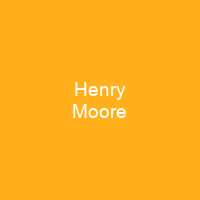Henry Spencer Moore OM CH FBA was an English artist. He is best known for his semi-abstract monumental bronze sculptures. As well as sculpture, Moore produced many drawings, including a series depicting Londoners sheltering from the Blitz during the Second World War. Moore was instrumental in introducing a particular form of modernism to the United Kingdom.
About Henry Moore in brief

After the war, Moore received an ex-serviceman’s grant to continue his education and in 1919 he became a student at the Leeds School of Art, which set up a sculpture studio especially for him. In 1921, Moore won a scholarship at the Royal College of Art in London, along with Barbara Hepworth and other Yorkshire contemporaries. Moore later became uncomfortable with his classically derived ideals; he later became fascinated with primitivism and the influence of sculptors such as Constantin Brâncuși, Jacob Epstein, Henri Gaudier, Frank Dobier, and Frank Dobson. He was the youngest man in the Prince of Wales’ Own Civil Service Rifles regiment and was injured in 1917 in a gas attack, on 30 November at Bourlon Wood, during the Battle of Cambrai. After recovering in hospital, he saw out the remainder of the war as a physical training instructor, only returning to France as the Armistice was signed. He recalled later, ‘for me the war passed in a romantic haze of trying to be a hero.’ In 1940 he wrote, in a letter to his friend Arthur Sale, that the sight of a khaki uniform began to mean ‘everything in life that was wrong and wasteful and anti-life’ and I still have that feeling. He later became a teacher at the school he had attended, and became a professor at the University of Leeds.
You want to know more about Henry Moore?
This page is based on the article Henry Moore published in Wikipedia (as of Nov. 30, 2020) and was automatically summarized using artificial intelligence.







